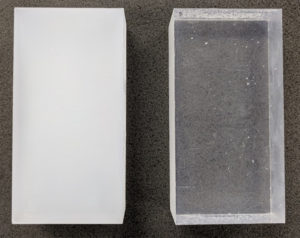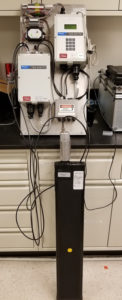Polyvinyl toluene (PVT) detectors are used in radiation portal monitors (RPM) around the world to detect the illicit trafficking of nuclear materials. Ernesto Ordonez-Ferrer is a student working with Center for Nuclear Security Science and Policy Initiatives (NSSPI) Deputy Director Dr. Craig Marianno on a project sponsored by the US Department of Energy’s National Nuclear Security Administration (NNSA) to help determine the health of PVT detectors.

According to Ordonez-Ferrer, “The main problem with these detectors is that they internally fog when subjected to freezing temperatures after experiencing a prolonged period of time in an environment with high heat and humidity. This fog eventually spreads throughout the plastic and decreases the efficiency and effectiveness of the equipment.”
Ordonez-Ferrer is part of a NSSPI team that is trying to find ways to signal when these detectors fog in a timely and efficient manner. The work began with the development of equipment to track changes in the PVT’s opacity during the onset of fogging of the detector, which was explored with 2020 NSSPI graduate Rainbow Suh and detailed in her master’s work.
“However,” said Ordonez-Ferrer, “Although the equipment developed for the first part of the project successfully tracked fogging, it ultimately introduced a lot of extra components to the RPM system.”
So Ordonez-Ferrer expanded upon this work to determine the state of health of the PVT detectors by using the photomultiplier tube (PMT) already deployed with the RPM and PVT detector.

“By utilizing the PMT,” he explained, “we can use the same data stream the RPM outputs to determine if the detector has fogged or not.”
Given the results from this research, RPM operators will be able to determine the state of health of these detectors on site without using extra equipment and by using data they are already receiving from the detectors.
Ordonez-Ferrer said that his decision to work with NSSPI began early in his studies. He originally decided to pursue a degree with a nuclear security specialization during his junior year as an undergraduate after taking Dr. Marianno’s emergency response class.

“At that time,” explained Ordonez-Ferrer, “I had been looking for something different to do within nuclear engineering other than reactors and reactor theory. Marianno’s emergency response class showed a completely different side of the industry that is not traditionally well advertised and essentially reinvigorated my passion for this field of work. Eventually I decided on working and designing radiation detection systems to aid first responders in the field and help maintain overall security of nuclear facilities.”
Ordonez-Ferrer said he values the many opportunities he had during his time at NSSPI to travel and interact with international students and visitors.
“I have helped Dr. Marianno with several emergency response exercises at Disaster City with visitors from Tokyo Tech University and the IAEA,” remarked Ordonez-Ferrer. “I have also participated in lectures/presentations with students from Tokyo Tech in Spring 2018 and Spring 2020.”
Finally, Ordonez was able to visit Japan as part of the 2018 International Nuclear Facilities Experience, which is organized by NSSPI and Argonne National Laboratory.

Ordonez-Ferrer earned his B.S. in nuclear engineering from Texas A&M University in May of 2017. In 2020, he was awarded a Seaborg Institute Graduate Research Fellowship to study at Los Alamos National Laboratory, which was unfortunately impacted by the COVID-19 situation. He will be graduating in May of 2021 with a M.S. degree in nuclear engineering. After graduation, Ordonez-Ferrer will work as a staff engineer at IB3 Global Solutions in Oak Ridge, Tennessee working with their test and evaluation team.